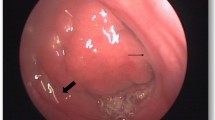Abstract
Biofilms have been implicated in the development of several chronic upper respiratory tract infections. Role of bacterial biofilms has been well studied in the pathogenesis of chronic rhinosinusitis. However, its impact on development of middle ear effusion is still a matter of debate. To study the extent of surface adenoid biofilm and evaluate its role in the pathogenesis of chronic otitis media with effusion in children. The study was carried out on 40 children in Alexandria Main University Hospital between 1 and 16 years of age without sex predilection, who were divided into two groups. The first group (20 children) had otitis media with effusion associated with adenoid hypertrophy, whereas the second group (20 children) had adenoid hypertrophy without middle ear effusion. Adenoidectomy with ventilation tube insertion was done for group 1 cases, whereas, only Adenoidectomy was done for group 2 cases. The samples were processed for the detection of biofilms by scanning electron microscopy. The biofilm formation was graded according to extension. Biofilm formation was detected on all samples for group 1. Adenoids removed from patients with otitis media with effusion had higher-grade biofilm formation than the other group (P 0.0001). No correlation was found between adenoid size and biofilm formation. In pediatric population, adenoid surface biofilm formation may be involved in the pathogenesis otitis media with effusion.





Similar content being viewed by others
References
Bluestone CD (1984) State of the art: definitions and classifications. In: Liu DJ, Bluestone CD, Klien JO, Nelson JD (eds) Recent advances in otitis media with effusion. Proceedings of the 3rd international conference. Decker and Mosby, Ontario
Teele DW, Klein JO, Rosner B (1989) The Greater Boston Otitis Media Study Group: epidemiology of otitis media during the first 7 years of life in children in Greater Boston: a prospective cohort study. J Infect Dis 160:83–94
Richardson MA (1999) Sore throat, tonsillitis and adenoiditis. Med Clin N Am 83:75–83
Yasan H, Dogru H, Tuz M, Candir O, Uygur K, Yariktas M (2003) Otitis media with effusion and histopathologic properties of adenoid tissue. Int J Pediatr Otorhinolaryngol 67:1179–1183
Fergie N, Bayston R, Pearson JP, Birchall JP (2004) Is otitis media with effusion a biofilm infection? Clin Otolaryngol Allied Sci 29:38–46
Rayner MG, Zhang Y, Gorry MC, Chen Y, Post JC, Ehrlich GD (1998) Evidence of bacterial metabolic activity in culture-negative otitis media with effusion. JAMA 279:296–299
Hendolin PH, Kärkkäinen U, Himi T, Markkanen A, Ylikoski J (1999) High incidence of Alloiococcus otitis in otitis media with effusion. Pediatr Infect Dis J 18:860–865
Güvenç MG, Midilli K, Inci E, Kuşkucu M, Tahamiler R, Ozergil E et al (2010) Lack of Chlamydophila pneumoniae and predominance of Alloiococcus otitidis in middle ear fluids of children with otitis media with effusion. Auris Nasus Larynx 37(3):269–273
Ehrlich GD, Veeh R, Wang X, Costerton JW, Hayes JD, Hu FZ et al (2002) Mucosal biofilm formation on middle-ear mucosa in the chinchilla model of otitis media. JAMA 287(13):1710–1715
Sauer K (2003) The genomics and proteomics of biofilm formation. Genome Biol 4:219
Stoodley P, Sauer K, Davies DG, Costerton JW (2002) Biofilms as complex differentiated communities. Annu Rev Microbiol 56:187–209
O’Toole G, Kaplan HB, Kolter R (2000) Biofilm formation as microbial development. Annu Rev Microbiol 54:49–79
Lewis K (2008) Multidrug tolerance of biofilms and persister cells. Curr Top Microbiol Immunol 322:107–131
Foreman A, Wormald PJ (2010) Different biofilms, different disease? A clinical outcomes study. Laryngoscope 120:1701–1706
Hall-Stoodley L, Stoodley P (2005) Biofilm formation and dispersal and the transmission of human pathogens. Trends Microbiol 13:7–10
Sanglard D (2002) Resistance of human fungal pathogens to antifungal drugs. Curr Opin Microbiol 5:379–385
Kania RE, Lamers GE, Vonk MJ, Dorpmans E, Struik J, Tran Ba Huy P et al (2008) Characterization of mucosal biofilms on human adenoid tissues. Laryngoscope 118:128–134
Zuliani G, Carron M, Gurrola J, Coleman C, Haupert M, Berk R et al (2006) Identification of adenoid biofilms in chronic rhinosinusitis. Int J Pediatr Otorhinolaryngol 70:1613–1617
Saafan ME, Ibrahim WS, Tomoum MO (2013) Role of adenoid biofilm in chronic otitis media with effusion in children. Eur Arch Otorhinolaryngol 270(9):2417–2425
Chloe RA, Faddis BT (2003) Anatomical evidence of microbial biofilms in tonsillar tissue: a possible mechanism to explain chronicity. Arch Otolaryngol Head Neck Surg 129:634–636
Kadhim AL, Spilsbury K, Semmens JB, Coates HL, Lannigan FJ (2007) Adenoidectomy formiddle ear effusion: a study of 50,000 children over 24 years. Laryngoscope 117(3):427–433
Coyte PC, Croxford R, McIsaac W, Feldman W, Friedberg J (2001) The role of adjuvant adenoidectomy and tonsillectomy in the outcome of the insertion of tympanostomy tubes. N Engl J Med 344(16):1188–1195
Saylam G, Tatar EC, Tatar I, Ozdek A, Korkmaz H (2010) Association of adenoid surface biofilm formation and chronic otitis media with effusion. Arch Otolaryngol Head Neck Surg 136:550–555
Hoa M, Syamal M, Schaeffer MA, Sachdeva L, Berk R, Coticchia J (2010) Biofilms and chronic otitis media: an initial exploration into the role of biofilms in the pathogenesis of chronic otitis media. Am J Otolaryngol 31:241–245
Author information
Authors and Affiliations
Corresponding author
Ethics declarations
Conflict of interest
All authors have no conflict of interest.
Ethical approval
All procedures performed in studies involving human participants were in accordance with the ethical standards of the institutional and/or national research committee and with the 1964 Helsinki declaration and its later amendments or comparable ethical standards.
Informed consent
Informed consent was taken from parents of children involved in the study before making any procedure.
Rights and permissions
About this article
Cite this article
Tawfik, S.A.ES., Ibrahim, A.A., Talaat, I.M. et al. Role of bacterial biofilm in development of middle ear effusion. Eur Arch Otorhinolaryngol 273, 4003–4009 (2016). https://doi.org/10.1007/s00405-016-4094-2
Received:
Accepted:
Published:
Issue Date:
DOI: https://doi.org/10.1007/s00405-016-4094-2




